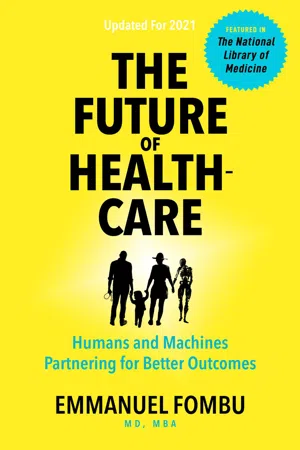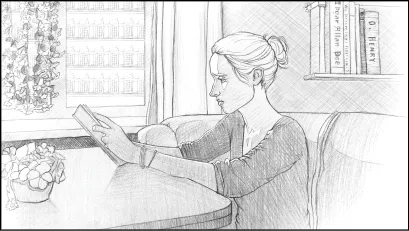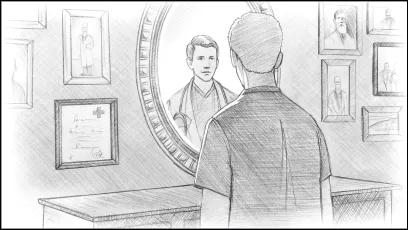
eBook - ePub
The Future of Healthcare
Humans and Machines Partnering for Better Outcomes
- English
- ePUB (mobile friendly)
- Available on iOS & Android
eBook - ePub
The Future of Healthcare
Humans and Machines Partnering for Better Outcomes
About this book
We live in a world where data can help us make more informed decisions about how to navigate traffic, who to date, what to buy, who to network with and how to better manage our finances.
But when it comes to our personal health and wellness, we have no roadmap. We need something to show us where we are in terms of our health, with landmarks for risks and opportunities. A GPS that makes it easier to move toward our personal health goals. A new way to look at health and life.
The future of healthcare is coming. This is what it looks like.
Frequently asked questions
Yes, you can cancel anytime from the Subscription tab in your account settings on the Perlego website. Your subscription will stay active until the end of your current billing period. Learn how to cancel your subscription.
At the moment all of our mobile-responsive ePub books are available to download via the app. Most of our PDFs are also available to download and we're working on making the final remaining ones downloadable now. Learn more here.
Perlego offers two plans: Essential and Complete
- Essential is ideal for learners and professionals who enjoy exploring a wide range of subjects. Access the Essential Library with 800,000+ trusted titles and best-sellers across business, personal growth, and the humanities. Includes unlimited reading time and Standard Read Aloud voice.
- Complete: Perfect for advanced learners and researchers needing full, unrestricted access. Unlock 1.4M+ books across hundreds of subjects, including academic and specialized titles. The Complete Plan also includes advanced features like Premium Read Aloud and Research Assistant.
We are an online textbook subscription service, where you can get access to an entire online library for less than the price of a single book per month. With over 1 million books across 1000+ topics, we’ve got you covered! Learn more here.
Look out for the read-aloud symbol on your next book to see if you can listen to it. The read-aloud tool reads text aloud for you, highlighting the text as it is being read. You can pause it, speed it up and slow it down. Learn more here.
Yes! You can use the Perlego app on both iOS or Android devices to read anytime, anywhere — even offline. Perfect for commutes or when you’re on the go.
Please note we cannot support devices running on iOS 13 and Android 7 or earlier. Learn more about using the app.
Please note we cannot support devices running on iOS 13 and Android 7 or earlier. Learn more about using the app.
Yes, you can access The Future of Healthcare by Emmanuel Fombu, Dane Cobain in PDF and/or ePUB format, as well as other popular books in Medicine & Health Care Delivery. We have over one million books available in our catalogue for you to explore.
Information
Chapter One: The Future of Healthcare
“The ability to cultivate mass amounts of data to zero in on cures and new techniques to enhance the speed of healing [is what excites me most about our digital future].”
– Bill Peacock, COO of Cleveland Clinic
– Bill Peacock, COO of Cleveland Clinic
LET ME TAKE YOU on a journey through space and time.
We’re heading into the future. It’s not as close as the day after tomorrow and it’s not as far as 4,000 AD when humanity has colonized space and moved way beyond the solar system. It’s somewhere in between, a future that’s within our reach thanks to the exciting technology that’s already around today.
We’re going to follow the stories of three people to see the future of healthcare in action, and in the next chapter we’re going to take a look at how the future of healthcare contrasts with where we are today.

Meet Diana
Diana is a 53-year-old library assistant with two loving children and a husband who works in real estate. The family doesn’t really need the money, but she loves her job and the smell of books is like a drug to her. The thought of all of those books – all of that knowledge – gets her out of bed in the morning.
Well, her virtual assistant helps, too.
At precisely 7:15 AM every weekday, she’s woken by the chirpy tones of Amazon’s Alexa. Alexa knows that 7:15 AM is the best time for Diana to wake up based on her body’s circadian rhythm and the metrics it receives from her smartwatch. When she gets up earlier – or later – she typically gets less exercise, which can then affect her blood pressure.
Diana’s story began on a typical morning. Alexa woke Diana by slowly raising the lights and playing classical music, which helped to bring her gently to consciousness instead of waking her with a jolt. She sighed and stretched, noticing as she did so that her shoulder was stiff and there was a dull ache in her foot.
“Good morning, Diana,” Alexa said. “You slept well. I make it just under eight hours, which is within the healthy range for a woman of your age. Don’t forget to take your medication.”
“Thanks, Alexa,” Diana replied. She pulled herself out of bed, walked over to the dressing table where her atenolol was already waiting and swallowed it down with a glass of water. Then she walked over towards her wardrobe.
“Diana,” Alexa said. “It looks like you’re limping. Is something wrong?”
“Ah,” Diana replied. “It’s nothing. I must have stubbed my toe.”
“Are you sure?”
“No,” Diana admitted. So Alexa asked her a checklist of questions, routing the answers through a set of algorithms to determine a preliminary diagnosis.
“Diana,” Alexa said, “I think you ought to go to the hospital. It might be nothing, but I’m worried about potential infections and I lack the equipment to fully scan you. Would you like me to call a taxi?”
“Sure thing,” Diana said, and before she knew it she was in the back of an Uber and worming her way through the streets towards the hospital. She felt a little silly about bothering the doctors with a sore foot, but she remembered the last time she’d ignored Alexa’s advice, when she’d thought she had a cold and ended up being diagnosed with mild pneumonia.
At the hospital, the waiting room was almost empty. Diana checked in at the desk and was quickly ushered in to speak to the doctor.
“Hi, Diana,” he said. “My name’s Dr. Barlow. TREWS tells me that we’ll need to run some further tests, I hope that’s okay.”
“TREWS?”
The doctor nodded. “Our targeted real-time early warning system,” he said. “It uses machine learning to analyze data from patients to pick up on symptoms that we might otherwise miss. Your creatinine level is a little high.”
“What does that mean?”
“Let’s find out,” the doctor said.
High creatinine levels can be caused by multiple different conditions, including sepsis and chronic kidney disease, so Dr. Barlow and his team carried out a battery of tests. Based on Diana’s medical history and the analysis of other patients with similar attributes, Barlow and his team knew that kidney disease was an unlikely suspect, and his virtual assistant calculated that there was a 93% chance that they were dealing with sepsis.
Barlow took a chance and started Diana on antibiotics, then told her she could go back home as long as she wore a hospital health tracker and sent in a digital blood sample using one of their disposable kits.
Two days later, Diana’s creatinine levels were back to normal and she’d never felt better.
“Good morning, Diana,” Alexa said. “You’re looking well today.”

Meet Omar
Omar had always wanted to be a physician. His father was a doctor, his grandfather was a surgeon, and his great grandfather had been a medic during the Second World War. It was a family tradition.
One morning, Omar was woken up as normal by a gentle vibration from his health tracker. He wore it on his wrist so that it could track his vitals and help him to maintain a steady sleep cycle. But on that morning, it detected something unusual, so it routed the data through the cloud and crunched the numbers, comparing Omar’s vitals to those of other people of his age and ethnicity.
Omar’s phone went off, so he answered the incoming Skype call. As soon as the video feed loaded, he could see who it was – Dr. Groves was calling, which usually wasn’t good news.
“Hi Omar,” Dr. Groves said. “How are you?”
“I’m okay, doc,” Omar replied. “What’s up?”
“Just a quick one,” the doctor said. “Your tracker tells me that your blood pressure is a little high. It’s not necessarily something to worry about, but I think we’d both feel a lot better if we checked it out. I was wondering if you could stop by today to give us a blood sample?”
“Sure thing. Let me just get dressed.”
“Great,” Dr. Groves said. “I’ll see you later.”
Omar hopped on the back of his bicycle and rode to the local medical center where Dr. Groves worked. The doctor was busy on his daily rounds, most of which were carried out remotely, and so Omar was greeted by a nurse called Joy who directed him into a side room and showed him how to use the bloodwork machine.
“It’s easy,” she said. “Just put your thumb in the hole and you’ll feel a quick prick from the needle. It’ll be over before you know it.”
“What happens then?” Omar asked.
“The machine will destroy the needle and prepare a new one for the next patient,” Joy replied. “Meanwhile, we’ll analyze the blood and get Dr. Groves to t...
Table of contents
- preface to 2nd Edition
- Introduction
- Chapter One: The Future of Healthcare
- Chapter Two: The Current System
- Chapter Three: Value-Based Healthcare
- Chapter Four: The Internet of Things
- Chapter Five: Big Data
- Chapter Six: Artificial Intelligence
- Chapter Seven: Machine Learning
- Chapter Eight: The Future for Patients
- Chapter Nine: The Future for Big Pharma
- Chapter Ten: the Future for Physicians
- Chapter Eleven: The Future for Hospitals
- Chapter Twelve: The Future for Insurers
- Chapter Thirteen: The Future for Governments
- Chapter Fourteen: Man and Machine
- Chapter Fifteen: Innovation Challenges
- Chapter Sixteen: To the Future!
- Acknowledgements
- About the Author